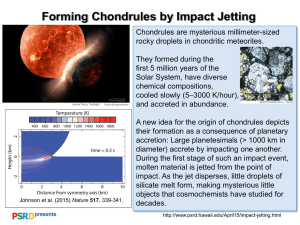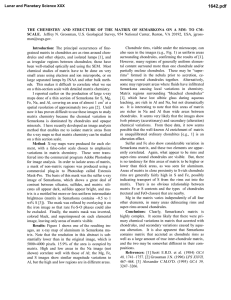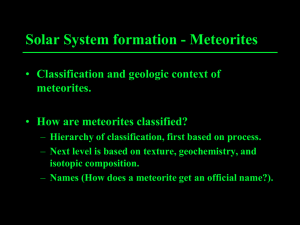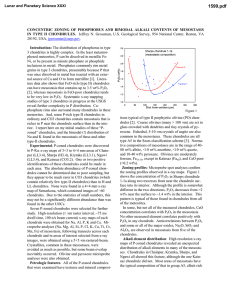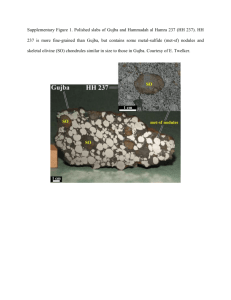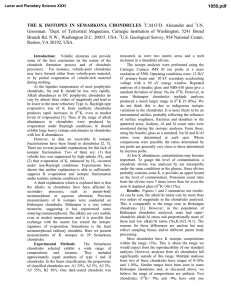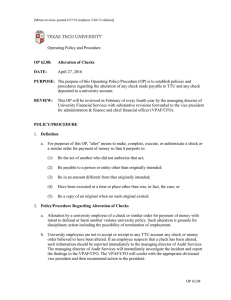ZONING OF TRACE ELEMENTS AND DEUTERIUM IN THE MESOSTASIS OF... SEMARKONA. , C. M. O’D. Alexander , and J. Wang
advertisement
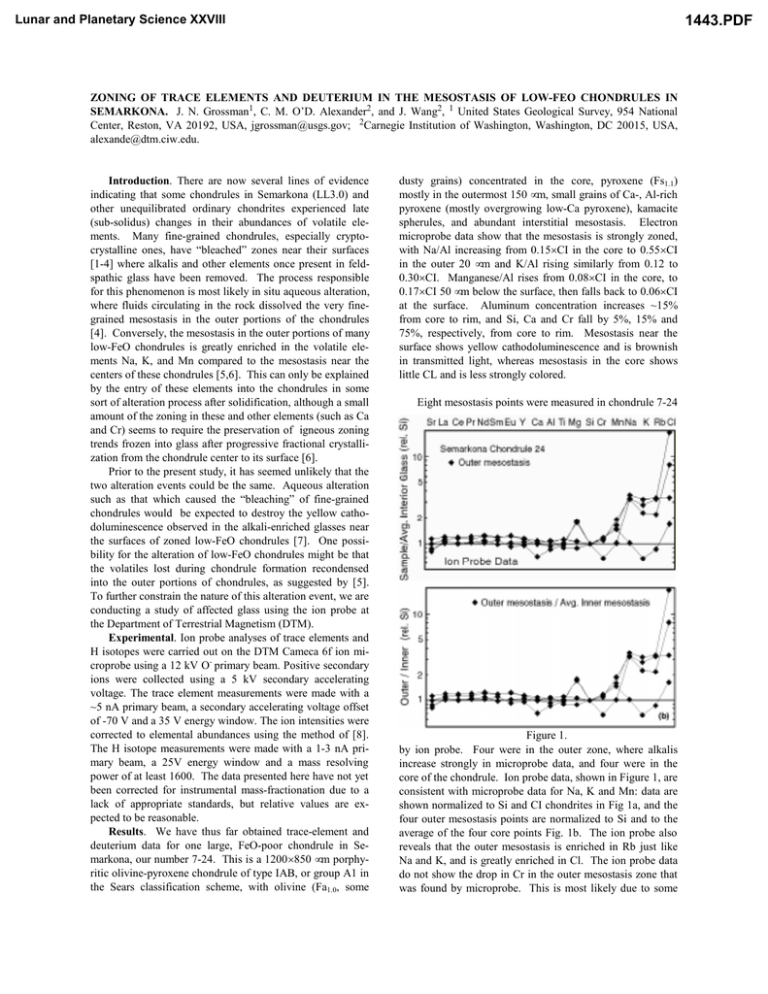
Lunar and Planetary Science XXVIII 1443.PDF ZONING OF TRACE ELEMENTS AND DEUTERIUM IN THE MESOSTASIS OF LOW-FEO CHONDRULES IN SEMARKONA. J. N. Grossman1, C. M. O’D. Alexander2, and J. Wang2, 1 United States Geological Survey, 954 National Center, Reston, VA 20192, USA, jgrossman@usgs.gov; 2Carnegie Institution of Washington, Washington, DC 20015, USA, alexande@dtm.ciw.edu. Introduction. There are now several lines of evidence indicating that some chondrules in Semarkona (LL3.0) and other unequilibrated ordinary chondrites experienced late (sub-solidus) changes in their abundances of volatile elements. Many fine-grained chondrules, especially cryptocrystalline ones, have “bleached” zones near their surfaces [1-4] where alkalis and other elements once present in feldspathic glass have been removed. The process responsible for this phenomenon is most likely in situ aqueous alteration, where fluids circulating in the rock dissolved the very finegrained mesostasis in the outer portions of the chondrules [4]. Conversely, the mesostasis in the outer portions of many low-FeO chondrules is greatly enriched in the volatile elements Na, K, and Mn compared to the mesostasis near the centers of these chondrules [5,6]. This can only be explained by the entry of these elements into the chondrules in some sort of alteration process after solidification, although a small amount of the zoning in these and other elements (such as Ca and Cr) seems to require the preservation of igneous zoning trends frozen into glass after progressive fractional crystallization from the chondrule center to its surface [6]. Prior to the present study, it has seemed unlikely that the two alteration events could be the same. Aqueous alteration such as that which caused the “bleaching” of fine-grained chondrules would be expected to destroy the yellow cathodoluminescence observed in the alkali-enriched glasses near the surfaces of zoned low-FeO chondrules [7]. One possibility for the alteration of low-FeO chondrules might be that the volatiles lost during chondrule formation recondensed into the outer portions of chondrules, as suggested by [5]. To further constrain the nature of this alteration event, we are conducting a study of affected glass using the ion probe at the Department of Terrestrial Magnetism (DTM). Experimental. Ion probe analyses of trace elements and H isotopes were carried out on the DTM Cameca 6f ion microprobe using a 12 kV O- primary beam. Positive secondary ions were collected using a 5 kV secondary accelerating voltage. The trace element measurements were made with a ~5 nA primary beam, a secondary accelerating voltage offset of -70 V and a 35 V energy window. The ion intensities were corrected to elemental abundances using the method of [8]. The H isotope measurements were made with a 1-3 nA primary beam, a 25V energy window and a mass resolving power of at least 1600. The data presented here have not yet been corrected for instrumental mass-fractionation due to a lack of appropriate standards, but relative values are expected to be reasonable. Results. We have thus far obtained trace-element and deuterium data for one large, FeO-poor chondrule in Semarkona, our number 7-24. This is a 1200×850 µm porphyritic olivine-pyroxene chondrule of type IAB, or group A1 in the Sears classification scheme, with olivine (Fa1.0, some dusty grains) concentrated in the core, pyroxene (Fs1.1) mostly in the outermost 150 µm, small grains of Ca-, Al-rich pyroxene (mostly overgrowing low-Ca pyroxene), kamacite spherules, and abundant interstitial mesostasis. Electron microprobe data show that the mesostasis is strongly zoned, with Na/Al increasing from 0.15×CI in the core to 0.55×CI in the outer 20 µm and K/Al rising similarly from 0.12 to 0.30×CI. Manganese/Al rises from 0.08×CI in the core, to 0.17×CI 50 µm below the surface, then falls back to 0.06×CI at the surface. Aluminum concentration increases ~15% from core to rim, and Si, Ca and Cr fall by 5%, 15% and 75%, respectively, from core to rim. Mesostasis near the surface shows yellow cathodoluminescence and is brownish in transmitted light, whereas mesostasis in the core shows little CL and is less strongly colored. Eight mesostasis points were measured in chondrule 7-24 Figure 1. by ion probe. Four were in the outer zone, where alkalis increase strongly in microprobe data, and four were in the core of the chondrule. Ion probe data, shown in Figure 1, are consistent with microprobe data for Na, K and Mn: data are shown normalized to Si and CI chondrites in Fig 1a, and the four outer mesostasis points are normalized to Si and to the average of the four core points Fig. 1b. The ion probe also reveals that the outer mesostasis is enriched in Rb just like Na and K, and is greatly enriched in Cl. The ion probe data do not show the drop in Cr in the outer mesostasis zone that was found by microprobe. This is most likely due to some Lunar and Planetary Science XXVIII 1443.PDF ZONING OF MESOSTASIS IN SEMARKONA CHONDRULES: J. N. Grossman and C. M. O’D. Alexander beam overlap with Ca-rich pyroxene grains in the glass during ion probe analysis. Other elements measured by ion probe, including rare earths, Y, Sr and Ti, show little corerim zoning in the mesostasis. Ion probe data for hydrogen (recalculated as H2O) and Figure 2. uncorrected data for δD (rel. SMOW) in the same eight points of chondrule 7-24 are shown in Fig. 2. Data are plotted against Na, which is high in the three outer points most affected by the secondary alteration process (the fourth outer point, while close to the chondrule surface, is not high in Na due to a small amount of asymmetry in the mesostasis zoning profile). Clearly, both water content, and the isotopic composition of this water are correlated with alkali enrichment: glasses near the chondrule surface contain a few tenths of a wt.% of very D-rich water. Discussion. The mesostasis near the surface of chondrule 7-24 is enriched in all of the volatile elements measured thus far, including Na, K, Rb, Mn, Cl and H. The new data confirm previous conclusions that these enrichments are due to secondary alteration, and are far too large to be caused by any igneous processes [5, 6]. The very high water content of this glass is almost certainly an indication of lowtemperature alteration, and the extremely heavy δD values preclude any kind of terrestrial process. It seems unlikely that this suite of volatile elements could represent recondensed volatiles originally lost during chondrule heating. These elements would condense out of the gas over an enormous temperature range, yet their zoning profiles are all similar. Recondensation also cannot explain why water in the chondrule core has a low D/H ratio, while water near the surface is quite heavy. It seems much more likely that these elements entered via light aqueous alteration of glass near the chondrule surface. Aqueous alteration, as simulated in the experiments of [7], rapidly destroyed the yellow CL typical of many lowFeO chondrules. They used 0.1 molar solutions of Na and Ca chlorides, temperatures of 200-300°C, and a pressure of 0.5 kbar. Clearly the conditions experienced by the naturally altered chondrules were much less severe than this, allowing at least some of the yellow-luminescing material, presumably glass, to survive. We conclude that fluids circulating through the chondrite matrix, or material like it, became enriched in soluble elements like alkalis and Cl, and transported these into some chondrules as water reacted with the glass. Ion probe experiments have shown that matrix material has a very high D/H ratio once contamination by terrestrial water is taken into account [9]; we confirm this conclusion with our own matrix analyses. The fluid probably became enriched in D as it equilibrated with the matrix. We still do not know if the dissolution of glass in finegrained chondrules, which is almost certainly a parent-body process, occurred in the same event as the alteration of lowFeO chondrules. For this to be true, there needs to be a strong dependence of the degree of alteration on the composition of the glass under the appropriate conditions and fluid composition for these chondrites. More data and experiments may supply the answer to this question. References: [1] G. Kurat (1969) in Meteorite Research, Reidel Publ. Co., 185-190. [2] M. Christophe Michel-Levy (1976) Earth. Planet. Sci. Letts. 30, 143-150. [3] W. R. Skinner et al. (1989) Meteoritics 24, 326. [4] J. N. Grossman (1996) LPS 27, 467-468. [5] Matsunami et al. (1993) Geochim. Cosmochim. Acta 57, 2101-2110. [6] J. N. Grossman (1996) Meteorit. Planet. Sci. 31, A55-A56. [7] J. M. DeHart and G. E. Lofgren (1996) Geochim. Cosmochim. Acta 60, 2233-2242. [8] C. M. O’D. Alexander (1994) Geochim. Cosmochim. Acta 58, 3451-3468. [9] E. Deloule and F. Robert (1995) Geochim. Cosmochim. Acta 59, 4695-4706.
